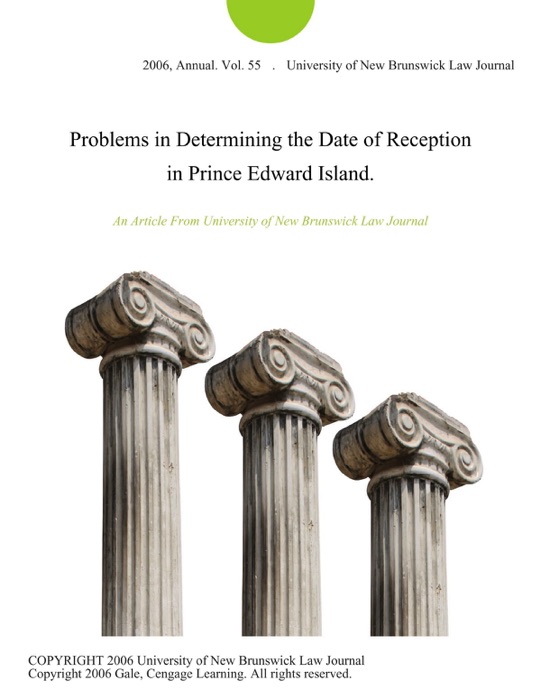(Download) "Problems in Determining the Date of Reception in Prince Edward Island." by University of New Brunswick Law Journal ~ eBook PDF Kindle ePub Free

eBook details
- Title: Problems in Determining the Date of Reception in Prince Edward Island.
- Author : University of New Brunswick Law Journal
- Release Date : January 01, 2006
- Genre: Law,Books,Professional & Technical,
- Pages : * pages
- Size : 262 KB
Description
When lawyers need to know the law on a particular subject in a Canadian province or territory, they check the relevant legislation and case law. Assuming that the lawyer is dealing with a matter within provincial rather than federal jurisdiction, the lawyer must consider whether there is something of relevance not only in statutes that have been enacted by the legislature of the province or territory, but in statutes that might have been included in the body of law that applied when the legislature came into existence. A colony governed by the law of England begins life endowed with the wisdom and learning expressed in judicial decisions and in the legislation of England, or at least as much of the legislation as was suited to the circumstances of the colony. The colony receives whatever law exists at a date known as the date of reception. Legislatures may choose a date of reception by legislation, but the legislature in Prince Edward Island has made no such choice. In these circumstances, the date of reception depends on the specific history of the colony, including how it came to be a British colony, who lived there previously, and when the colonial legislature first met. (1) The date of reception of English law in Prince Edward Island, then, is found somewhere in the chronology that follows, but exactly which date is still an open question. Long before Prince Edward Island was a British colony or a Canadian province, the Mi'kmaq inhabitants knew it as Abegweit or Minago. (2) The earliest French explorers and settlers noted the presence of Mi'kmaq on the Island, but gave the place a new name, Ile Saint-Jean. (3) The French capitulation to the British at Louisbourg on 26 July 1758 included an agreement that French soldiers would be removed from lie Saint-Jean as soon as the British acquired transport. The British, however, decided to evacuate the Acadian and Mi'kmaq inhabitants, too, although two hundred or so of each group avoided evacuation and remained on the Island. The Treaty of Paris, signed on 10 February 1763, confirmed Britain's sovereignty over lie Saint-Jean, which the British treated as an uninhabited territory. The French name was anglicized to Island of Saint John or Saint John's Isle, and the territory annexed to the existing British colony of Nova Scotia by the Royal Proclamation of 7 October 1763. A government survey divided the Island into 67 lots, or townships, of around 20,000 acres each and on 23 July 1767 these were allocated by lottery to a carefully-selected group of about one hundred individuals. Some of these estate holders petitioned the Crown to make the Island a separate colony, and on 14 July 1769, the Crown issued a commission to the new colony's first governor, Walter Patterson. Patterson convened the first meeting of his legislative council on 19 September 1770 and opened the first session of the Island's first elected assembly on 7 July 1773. (4)